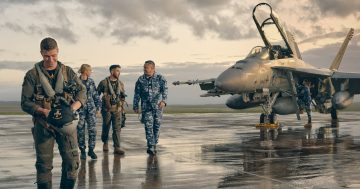
The Federal Government accepts that while there is a place for defence assets to be used in the event of a national emergency, it should be the last call made, not the first. Photo: ADF.
The Federal Government has launched a consultation paper seeking alternative options on how best to handle future national disaster responses.
The Alternative Commonwealth Capabilities for Crisis Response paper was launched by Minister for Emergency Management Murray Watt on 9 August. It is hoped the responses to it will help inform the Department of Home Affairs and National Emergency Management Agency (NEMA) on how to develop future policies on providing disaster recovery assistance to states and territories.
The paper comes in the wake of April’s Defence Strategic Review (DSR) which identified that, in recent years, the Australian Defence Force (ADF) has often been the first point of contact in providing responses.
While Defence had manpower, equipment and know-how, the DSR also highlighted it was currently under-manned and under-equipped. Therefore, every time it is called up for such a disaster response, that equipment and manpower is drawn away from its primary role – military defence of the nation.
“The Australian Defence Force is frequently relied upon to support domestic disaster relief efforts – support that we are all thankful for,” Minister Watt said in the release.
“This is not about removing Defence from disaster response – when Australians find themselves in an emergency situation where Defence has a unique capability to bring to bear, then the ADF will always be there.
“In line with the Defence Strategic Review, this is about making sure Defence is not the first call that’s made – it is the last.”
He said because of this, the Government had agreed in-principle to work with the states and territories at the local level to develop national resilience and response measures for adverse climate change without the need of ADF support, except in the most extreme emergencies.
The paper acknowledges crisis response and recovery begins at the community level, and as crises escalate, while local governments, states and territories are the first responders in Australia’s emergency management system, the ADF will still have a role to play in those extreme emergencies.
But the former commander of Army’s Forces Command, Major General Gus McLachlan (Ret’d) said the Government needed to be careful with its messaging on how it used Defence for emergencies, and suggested the Army Reserve was actually well-suited to the task.
“This idea that the ADF is too busy to support our community – I’m not sure that’s the right approach,” he told Region.
“We have this growing disconnect between the ADF and the community, and there’s virtually no media profile of the leadership. So, I think the average member of the community wants to be reassured and get a benefit of having a defence force as well.”
He said the regular Army and the Reserve were quite distinctive. “The regular force, that’s where high tempo is and where some of the more exotic equipment resides,” he said.
“But the Reserve is one of the few parts of the Federal Government actually located in the regions.
“So, I think the Army Reserve is almost perfectly suited to this kind of work. What better training is there for a Reserve headquarters, ops planning teams, logisticians, and battalion commanding officers, than to come together and plan for emergency support?”
In the paper’s forward, Minister Watt said: “Over the coming decade, we expect that a wide range of threats and hazards will come together, exposing gaps in existing capacity and placing increased pressure on governments, institutions, economies and communities.
“While we have collectively made progress to enhance Australia’s disaster preparedness, response and resilience capability, we have to do much more to make sure we can handle the challenging future we expect to face.
“This is a whole-of-society issue that requires whole-of-society action.”
Mr Watt said work was already well underway to broaden the amount of support available through the Government’s October 2022 Budget commitment to Disaster Relief Australia, a veteran-led organisation that provided additional support for states and territories when disasters occurred.
He said this public consultation was being undertaken in parallel with, and will be complementary to, the work being done by the Senate Select Committee on Australia’s Disaster Resilience.
The consultation will include public online submissions, while stakeholder roundtables will be held throughout the rest of the year with various groups including state, territory and local governments, non-government organisations, not-for-profit groups, volunteer organisations and corporate Australia.





















